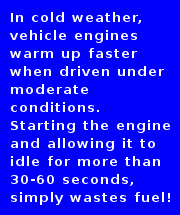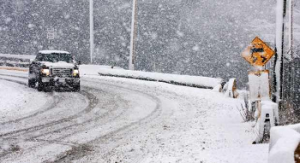Mental Survival Kit – Winter Driving Tips
December 3, 2014
At this time of year, traffic safety sites abound with articles about winter driving– most of which assert the importance of vehicle preparedness. Despite the importance of prepping your vehicle, a driver’s mental shift remains the key to safe commutes during inclement weather.
Allowing extra time, listening to road reports, easing up on the accelerator during adverse conditions and increasing space margins become the signposts of good winter driving. These techniques should be packed into your “mental survival kit” and will greatly increase your winter driving safety.
Despite many misperceptions about the winter season, car crashes during this time of year are actually at the annual lowest. Most collisions occur in the months of July and August. During bad weather, many it would appear, exercise prudence or postpone their travel plans.

Now tires are important, but many people drive the whole winter on their all-season tires – without incident. In many places throughout Canada and the US, it simply doesn’t make financial sense for most vehicles to be equipped with winter tires; in these locales, it only snows or freezes a couple of times during the whole winter season. The driver with the well equipped “mental survival kit” will postpone travel plans, find alternative transportation; or if she must go out, she will increase following distance, brake early and drive at reduced speeds.
That said, in many places in Canada and the US, winter tires are an absolute must.
Tow truck operators will tell you that the bulk of vehicles towed out of the ditch when roads become slippery are 4X4 vehicles. Sure, the 4-wheel drive grips provides better traction when in a forward motion, but the braking is compromised the same as any other vehicle. Owing to a false sense of safety, a significant number of 4-wheeled drive motorists are the first to end up in the proverbial “rhubarb”.
Don’t get me wrong – properly spec’d vehicles will better move, stop and manoeuvre through ice and snow. But driving safety continues to rest in the abilities of the driver. The driver’s “mental survival kit” should consist of several bits of relevant information:
- Weather information – what is the outside temperature. Media raves about the dangers of driving when it is snowing during subzero temperatures. Yet, road conditions are at their most treacherous when the temperature fluctuates around the 0°C (32°F) mark. (Ice around 0°C has a layer of water on top reducing the coefficient of friction – think of an ice hockey arena right after the Zamboni has flooded the ice.)
- If the outside temperature is at the freezing point, know that bridges, underpasses and shaded areas along the roadway will form ice first, and even though these frozen sections of roadway cannot be seen, the informed driver will be prepared for these compromised road conditions.
- What are the limitations of my vehicle – am I travelling too fast for the conditions and is my following distance enough to stop in the event of an emergency?
- Is my vehicle front, rear, or all-wheel drive? These different configurations respond differently in slippery conditions.
- Always brake before you actually need to stop. Owing to the sliding and slipping of cars at intersections, this is the spot on the highway where it is most slippery – so slow down to a crawl before actually getting to the intersection. As well, take off slowly from the intersection – spinning your wheels gets you nowhere and contributes to the slipperiness of the intersection.
- In slippery conditions steering and braking must occur independently of one another. In other words, brake first and slow the vehicle to “turning speed” and then manoeuvre the vehicle through the turn.
- Braking will improve if vehicles equipped with automatic transmissions are shifted into neutral. This technique requires some practice, so attempt it in a controlled area first. The bulk of automatic transmission levers can simply be tapped forward into “neutral”, and remain locked out of “reverse”. (Check the owner’s manual or test your transmission while stopped, if unsure.
- Know if your vehicle is equipped with Anti-lock brakes (ABS), as these often activate during hard braking on snow and ice. Grinding, growling and agitation of the brake pedal are all normal responses. Also, ABS brakes often increase the stopping distance required in slippery conditions.
- A locked or spinning wheel always leads. In other words, over-acceleration/braking/steering could potentially cause you to lose control of your vehicle.
- Before taking off in the morning, ensure that all windows are cleared of snow and ice. Leave one of the windows down and bit and turn on the “air conditioning” with the defroster to assist with keeping the windows clear. Practice turning on the windshield wipers and defroster without taking your eyes off the road for more than a split second.

Finally, know that vehicles warm up faster when driven under moderate conditions. Starting vehicles and allowing them to idle for more than 30-60 seconds, simply wastes fuel.
In the end, winter tires, emergency survival kits, and vehicle maintenance will reduce the stress of winter driving; however, most important is your own “mental survival kit”. Before putting the vehicle in motion, take a moment to ensure that your “mental survival kit” is properly equipped.





